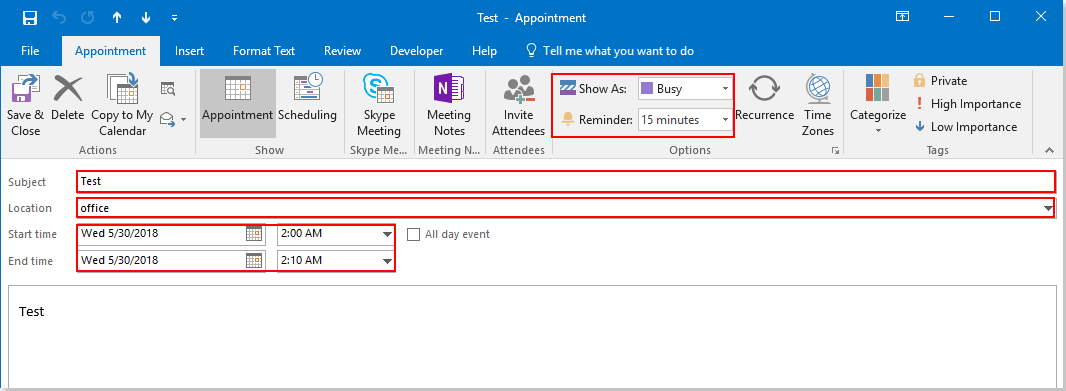Wie erstellt man Outlook-Erinnerungen aus einer Excel-Tabelle?
Dieser Artikel behandelt das Erstellen von Outlook-Erinnerungen basierend auf den Daten einer Excel-Tabelle.
Outlook-Erinnerungen aus einer Excel-Tabelle mit VBA-Code erstellen
Outlook-Erinnerungen aus einer Excel-Tabelle mit VBA-Code erstellen
Wenn Sie Outlook-Erinnerungen aus Excel erstellen möchten, gehen Sie bitte wie folgt vor.
1. Erstellen Sie ein Arbeitsblatt mit den Spaltenüberschriften und den entsprechenden Erinnerungsfeldern, wie im Screenshot unten gezeigt.

Notiz: Für die Spalte "Beschäftigt-Status" bedeutet die Zahl "2", dass die Erinnerung in Ihrem Outlook-Kalender als "Beschäftigt" angezeigt wird. Sie können sie nach Bedarf in "1 (Vorläufig)", "3 (Abwesend)", "4 (Arbeitet woanders)" oder "5 (kostenlos)" ändern.
2. Drücken Sie die Tasten "Alt" + "F11", um das Fenster "Microsoft Visual Basic für Applikationen" zu öffnen.
3. Klicken Sie im Fenster "Microsoft Visual Basic für Applikationen" auf "Einfügen" > "Modul". Kopieren Sie dann den folgenden VBA-Code in das Codefenster.
VBA-Code: Outlook-Erinnerungen aus einer Excel-Tabelle erstellen
Sub AddAppointments()
'Update by Extendoffice 20180608
Dim I As Long
Dim xRg As Range
Dim xOutApp As Object
Dim xOutItem As Object
Set xOutApp = CreateObject("Outlook.Application")
Set xRg = Range("A2:G2")
For I = 1 To xRg.Rows.Count
Set xOutItem = xOutApp.CreateItem(1)
Debug.Print xRg.Cells(I, 1).Value
xOutItem.Subject = xRg.Cells(I, 1).Value
xOutItem.Location = xRg.Cells(I, 2).Value
xOutItem.Start = xRg.Cells(I, 3).Value
xOutItem.Duration = xRg.Cells(I, 4).Value
If Trim(xRg.Cells(I, 5).Value) = "" Then
xOutItem.BusyStatus = 2
Else
xOutItem.BusyStatus = xRg.Cells(I, 5).Value
End If
If xRg.Cells(I, 6).Value > 0 Then
xOutItem.ReminderSet = True
xOutItem.ReminderMinutesBeforeStart = xRg.Cells(I, 6).Value
Else
xOutItem.ReminderSet = False
End If
xOutItem.Body = xRg.Cells(I, 7).Value
xOutItem.Save
Set xOutItem = Nothing
Next
Set xOutApp = Nothing
End SubNotiz: Im obigen Code ist "A2:G2" der Datenbereich, auf dessen Grundlage Sie Termine erstellen möchten.
4. Drücken Sie "F5" oder klicken Sie auf die Schaltfläche "Ausführen", um den Code auszuführen. Dann werden alle Termine mit spezifischen Feldern gleichzeitig in Ihren Outlook-Kalender eingefügt.
Dann können Sie den Kalender Ihres Outlook öffnen, um die Ergebnisse zu sehen. Siehe Screenshot:

Beste Office-Produktivitätstools
Eilmeldung: Kutools für Outlook veröffentlicht kostenlose Version!
Erleben Sie das brandneue Kutools für Outlook mit über100 unglaublichen Funktionen! Jetzt herunterladen!
📧 E-Mail-Automatisierung: Automatische Antwort (verfügbar für POP und IMAP)/E-Mail senden planen/Automatische CC/BCC nach Regel beim Senden von E-Mail/Automatische Weiterleitung (Erweiterte Regeln) /Begrüßung automatisch hinzufügen/E-Mails mit mehreren Empfängern automatisch in einzelne E-Mails aufteilen...
📨 E-Mail-Management: E-Mail zurückrufen/Betrugs-E-Mails nach Betreff und anderen Kriterien blockieren/Duplikate löschen/Erweiterte Suche/Ordner organisieren...
📁 Anhänge Pro:Stapel speichern/Stapel ablösen/Stapel komprimieren/Automatisch speichern/Automatisch abtrennen/Automatische Komprimierung...
🌟 Interface-Magie: 😊Mehr schöne und coole Emojis /Benachrichtigung bei wichtigen E-Mails/Outlook minimieren statt schließen...
👍 Ein-Klick-Genies: Allen mit Anhängen antworten /Anti-Phishing-E-Mails/🕘Zeitzone des Absenders anzeigen...
👩🏼🤝👩🏻 Kontakte & Kalender: Stapel Kontakt aus ausgewählten E-Mails hinzufügen/Kontaktgruppe in einzelne Gruppen aufteilen/Geburtstagserinnerung entfernen...
Verwenden Sie Kutools in Ihrer bevorzugten Sprache – unterstützt Englisch, Spanisch, Deutsch, Französisch, Chinesisch und über40 weitere!


🚀 Ein-Klick-Download — alle Office-Add-Ins verfügbar
Dringend empfohlen: Kutools für Office (5-in-1)
Mit einem Klick laden Sie fünf Installationsprogramme gleichzeitig herunter — Kutools für Excel, Outlook, Word, PowerPoint und Office Tab Pro. Jetzt herunterladen!
- ✅ Ein-Klick-Komfort: Laden Sie alle fünf Installationspakete in nur einem Schritt herunter.
- 🚀 Für jede Office-Aufgabe bereit: Installieren Sie die benötigten Add-Ins genau dann, wenn Sie sie brauchen.
- 🧰 Enthalten: Kutools für Excel / Kutools für Outlook / Kutools für Word / Office Tab Pro / Kutools für PowerPoint